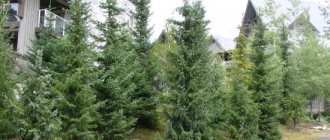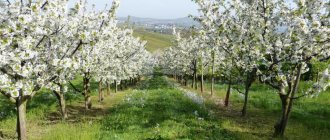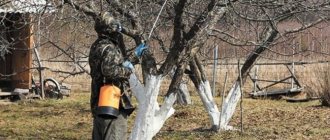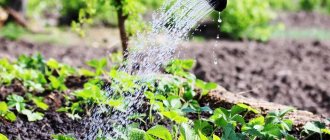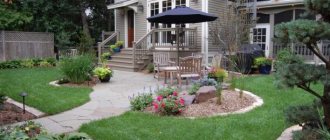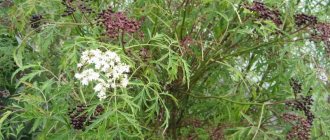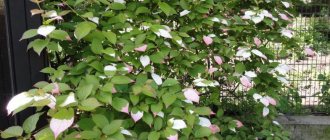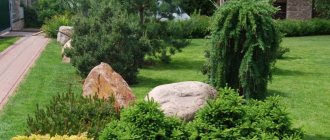When purchasing a plot of land and drawing up a plan for your future home, you definitely need to think about the placement of trees and shrubs, which are always planted first. This is explained not only by the size of the plants, but also by the relatively long period of growth before full flowering or fruiting. Of course, it is impossible to plant all the ornamental and fruit trees on a summer cottage due to the limited territory, so you have to choose.
And when deciding which trees to plant on a site, you need to focus on two principles:
- growing conditions: demanding or unpretentious species;
- main purpose, or place in the garden landscape (garden, hedge, single planting).
If we talk about fruit trees, apple trees require the simplest care (especially if you purchase a locally selected seedling that is resistant to common diseases and pests). Of course, unpretentious varieties do not have high taste, but they will not cause any trouble. But if you want to surprise your neighbors with something exotic, then you should think about planting yellow plum, actinidia, walnut or peach.
The same principle applies to ornamental trees and shrubs. For example, for a hedge you can use wild grapes, honeysuckle or drooping lilac, with minimal requirements for soil and climatic conditions, or you can decorate the area with juniper, barberry or hawthorn, which require a little more attention.
If you decide to plant a tree in your dacha, be sure to check the depth of the groundwater. Many trees, both fruit and ornamental, die as soon as their roots reach water. Such trees include the pear, which has a deeply penetrating root system. At first, the young seedling grows actively and pleases the owner, perhaps you will even be able to taste the first fruits, but then the tree begins to wither and dry up. Inexperienced gardeners complain about illness or poor-quality planting material and again buy and plant pear seedlings.
In order for tree plantings to truly become durable, it is necessary to take into account the requirements of each species for growing conditions.
Review of fruit trees and their features
Many people, having a summer cottage, want to plant fruit trees in the garden. For good fruiting, they require a high level of illumination, fertilizing, watering, pruning and preventive treatments against diseases and pests.
Blooming apple trees
Planting several varieties with the same ripening period has a beneficial effect on yield. To save space on the site, it is better to choose varieties with a compact crown shape on dwarf rootstocks. Below is a brief description of the main fruit crops according to the most significant parameters.
| Culture | Average life expectancy, years | Average tree height, m | Required power supply area, m | Preferred soils | Permissible depth of groundwater, m |
| Apple tree | from 20 to 50 | from 3 to 7 | 3x2 or 6x4 | slightly acidic | from 1 to 3 |
| Pear | 25 | 5 | 5x4 | any | 2 |
| Cherry | 25 | from 2 to 5 | 4x3 | neutral | 2 |
| Cherries | 60 | from 3 to 8 | 4x4 or 8x4 | neutral | 1,5 |
| Plum | 20 | 5 | 4x3 | neutral | 1,5 |
| Cherry plum | 20 | 2,5 | 3x3 | neutral | 1 |
| Apricot | 40-60 | from 5 to 10 | 5x6 | slightly alkaline | 2-2,5 |
| Kalina | 40 | 2,5 | 2x2 | slightly acidic | 1 |
| Irga | 50 | 2,5 | 3x2 | neutral | 1,5 |
| Honeysuckle | 20 | 1,5 | 2x1 | any | 1,5 |
| Sea buckthorn | 15 | from 3 to 5 | 2x2 | neutral | 1 |
| Rowan | 25 | 7 | 5x3 | slightly acidic | 2 |
| Hazel | 60 | 5 | 4x4 | slightly alkaline | 3 |
When choosing a fruit tree for a summer cottage, not only taste preferences, but also the climate zone play a big role. For example, chokeberry is recommended for the northern regions, as are honeysuckle and sea buckthorn, brought to central Russia from Siberia.
Rowan
Heat-loving cherry plums, plums, cherries and cherries are excellent in the southern regions. However, selection does not stand still and many crops adapt well to atypical regions thanks to their stable rootstock. An excellent example of this is Manchurian apricot and Siberian apricot, which are suitable for cultivation in Siberia and the Far East. And although such apricot has a specific, unattractive taste, it is quite successful in processing.
Manchurian apricot - mature tree
For rational use of the site, you can use grafting, which allows you to have several interesting varieties on one adult tree.
If you believe in the horoscope...
Many people use horoscopes when choosing plants. Astrologers say that when choosing which trees to plant on a plot near your house, it is important to take into account your zodiac sign. Each sign has its own plant. Trees act as patrons of the person who planted them and positively influence the energy of the entire yard. If you choose the right young plants and plant them near the house, the owner of the plot will have good luck everywhere.
Table 1: What trees can be planted on the site so that they correspond to the zodiac sign:
There is another type of horoscope - the Druid horoscope. Here there is a direct comparison of a person with a tree depending on the date of birth. Accordingly, those plants whose signs include people become patrons.
Table 2: Which deciduous trees are best to plant on the site according to the Druid horoscope:
That's the whole short course on choosing plants. We hope we helped you decide at least a little. All that remains is to wish you successful planting, but it’s up to you to decide which trees to plant on your site!
CONNECT WITH US
Overview of ornamental trees and shrubs
Decorative trees not only have an aesthetic function, but are often planted for shade near the gazebo, to protect against dust from the road, and to create a living border along the fence. Features of care depend on the type of plant and growing area.
Linden
There are trees that are undesirable to plant on a private plot because of aggressive growth or because of folk superstitions. Let's consider the most popular ornamental trees and shrubs in private landscape design from the point of view of their care and possible use.
Norway maple Globosum
| Culture | Short description | Usage | Note |
| Small-leaved linden | Tree up to 30 m high with a neat oval crown, high frost resistance, does not tolerate drought, the crown lends itself well to shaping | A shady tree with a pleasant fragrance during the flowering period, it is a honey plant, can be used for a hedge or planting along a fence, it holds dust well from the road | According to old sayings, the linden tree near the house protects against all diseases and illnesses. The young tree does not bloom, the first flowering is observed only in the 20-30th year of life, linden blossom is used in folk medicine |
| Norway maple | Tree up to 6 m high with a compact spherical crown, does not require frequent pruning, grows on any soil | Well suited for creating shade near a house or over an artificial pond, often planted along a fence or road | Used in folk medicine and cooking |
| Bird cherry | A tree from 4 to 10 m high, known for its snow-white racemose inflorescences with a bright aroma, undemanding to growing conditions | Due to the spreading wide crown, it is often planted singly at the edge of the plot or in alleys in a large garden. | It should not be planted close to the house, as its roots will destroy the foundation; produces edible fruits with medicinal properties |
| Poplar white (silver) | A fast-growing tree up to 30 m high with a spreading crown, has light bark and silver leaves, light-loving, salt-tolerant, tolerates drought and waterlogging, frost-resistant | Used in single or group plantings. For urban landscaping, pyramidal poplar is more often used, which does not form fluff, but has a large height. | It is not advisable to plant close to the house due to the aggressive root system; it cleans the air well of dust and harmful substances |
| Catalpa | A heat-loving tree 10-15 m high with a high spherical crown and an elegant, even trunk, the inflorescences are large, white, after flowering long pods are formed, giving additional decorativeness, does not tolerate pruning | Single plantings near the gazebo or near the house, during the flowering period it emits a very pleasant aroma, grows relatively slowly, may freeze in the Moscow region | People call it the “pasta tree” |
| Lilac | Abundantly flowering unpretentious shrub from 3 to 6 m high, the color of fragrant inflorescences is white or lilac in different shades, requires moderate pruning | Some varieties do not tolerate urban pollution, so it is not advisable to plant them near the road. Lilacs are ideal for hedges | It is popularly considered a protector of family well-being and a source of inspiration for creative people. |
| Barberry | A thorny shrub from 1 to 4 m high, with varied leaf colors (burgundy, yellow, green, purple), unpretentious in care | Used to create an impassable wall from dense thorny branches | Used in folk medicine, recommended for planting near home |
| Willow | A tree with drooping shoots, grows quickly, is easy to prune, tolerates significant waterlogging | Planting near water bodies or on waterlogged soils, hedges | A symbol of sadness and sadness, in the old days it was considered a bad omen to plant a willow tree under the window |
The list can go on for a long time, especially if we cover all the varieties and varieties. Breeders successfully cope with the task of “satisfying the needs of every gardener.”
Design solutions
Now let’s determine which ornamental trees to plant on the site to create a spectacular green area. Today the range of nurseries is very wide:
- deciduous: maple, chestnut, alder, birch, crimson, hazel, hawthorn, oleaster, ash, poplar, oak, sumac, robinia, willow, rowan, linden, elm, etc.
- conifers: fir, junipers, larches, microbiota, spruce, pine, hemlock and pseudosugi, yew;
- ornamental flowering and fruiting: chokeberry, barberry, boxwood, caragana, ceanothus, redroot, chaenomeles, quince, scumpia, wolfwort, deutia, Erica, euonymus, holteria, hydrangea, kalmias, kerria, privet, mahonia, pachysandra, buckthorn, rhododendron, azalea, elderberry, fieldfare, spirea, stephenendra, snowberry, etc.
First, let's decide which trees to plant on the site along the fence. In fact, you can add any type of plant to your yard. However, when planting vegetation near the fence, keep in mind that the minimum distance to the fence should be at least 3 m. This is one of the so-called rules of good neighborliness (described in more detail in the article “Tree Planting Standards” in the “Garden Care” section).
Now let's look at which trees to plant on a personal plot not near a fence, but to create a fence!
For a tall hedge, various types of hawthorns, barberries and yellow acacia (caragana) are perfect. The green wall will be quite high, with good “density”. This is excellent protection from all prying eyes. A little lower we will get a hedge of brilliant cotoneaster and spring-flowering species of spirea (Van Gutta, gray, arguta, oak-leaved). If you want to create a low green border, plant Kuril tea (cinquefoil), Thunberg barberry or low types of spirea (Japanese, Bumalda).
If you wish, you can experiment and try to protect yourself with a row of fruit-bearing trees. perhaps you will get not only a spectacular, but also a tasty fence
Below we have given example pictures: what trees to plant on the site (photo) and what your site will look like. These are just garden design options. We hope you can get some ideas for your yard.
Trust the landscaping of your yard to experienced gardeners. We will take care of your trees as if they were our own!
Trees that are undesirable in a garden plot according to ancient legends
Before planting a tree in front of your house, you can turn to the experience of our ancestors. At first glance, all signs are based on superstitions, but they often have a logical grain.
It is not recommended to plant an oak tree on a summer cottage, which has strong energy and influences the head of the family. Birch as a protective shield should only grow behind a fence. Walnuts should not be planted near the house, as their roots can eventually destroy the foundation. Willow, willow and aspen, the messengers of sorrow and death, are undesirable on the site.
If there are brides in the family, then it is also better to wait to plant thuja. It is recommended to plant poplar outside the site, away from the house.
How to remove a tree near the house?
An old tree can serve as a decoration for a garden and plot, but it is dangerous, because in a strong gust of wind it can break or fall on the roof of a private house. Based on this, it is better to play it safe and remove the tree, trusting specialists who have experience and the necessary equipment. As you know, a tree is never completely cut down; you need to start with medium and large branches, after which the plant is gradually sawed from top to bottom and taken out by truck.
Overview of coniferous ornamental trees
Evergreen and fairly unpretentious conifers serve as an indispensable element of any garden design.
For small areas of summer cottages, Arizona fir with gray-blue needles (height up to 2 m) and balsam fir (dwarf variety) are suitable. For those who want to grow a large tree, Korean fir (up to 15 m) is suitable.
Korean fir Silberlock
Dwarf varieties reaching a height of up to 3 m include Atlas cedar and Himalayan cedar. Among the large trees, Siberian cedar (cedar pine) enjoys well-deserved popularity. It grows slowly, but reaches very impressive sizes.
Siberian cedar (cedar pine)
Larch and spruce often decorate country houses with a large garden area. There are varieties of standard larch with a height of no more than 2.5 m with a spherical or weeping crown. Varieties of weeping larch look very impressive: the European dwarf variety Repens, up to 1.5 m high, with branches almost creeping along the ground, and the Japanese variety Pendula, up to 7 m high, with delicate green-blue needles.
Japanese larch Pendula
Dwarf forms of spruce can reach a height of 2 - 2.5 m, which, with slow growth, becomes acceptable in areas of any size. There are many varieties of dwarf spruce with different colored needles and different crown shapes. Blue spruce trees look the most beautiful and original, standing out effectively among the rest of the vegetation.
Blue spruce Hoopsie
Coniferous shrubs with different crown shapes include yew and juniper. In the landscape design of private plots, dwarf species of juniper with different colored needles (from dark green to silver-blue) up to 8 m in height are used.
Plum
Sweet and juicy plums are consumed fresh starting in July; they are suitable for freezing, canning, and drying. A young plum seedling begins to bear fruit already in the 4th year after planting and produces rapid growth and an annual and abundant harvest. The main conditions for successful fruiting are to place the plum in a well-lit place on the south side of the site and to form the crown as the seedling grows.
Among the early varieties, “Red Ball” and “Zarechnaya Rannyaya” have proven themselves well; among the later varieties, “Vengarianka” and “Stanley”.
Related article:
20 best varieties of lilac
Timing of tree planting and purchase of seedlings
It is difficult to unequivocally answer the question of when is the best time to plant trees. It depends on weather conditions and the specific crop. The optimal time for planting fruit trees from the pome group is late autumn, and for heat-loving stone fruits it is better to plant them in early spring. The preferred age of seedlings is 2 years, but for vigorous crops (pear, cherry) it is better to use annual seedlings. The negative side of annual seedlings is their unformed crown, but they suffer less pain when transplanted and take root faster.
Most ornamental crops are planted in spring. Moreover, the strict limits “before bud break” apply only to seedlings with an open root system. Planting material with a closed root system (in pots or bags) is suitable for planting throughout the spring and even in summer, but it is more expensive.
When purchasing seedlings at specialized exhibitions and fairs, you need to pay attention to the following points:
- in what form they are sold: seedlings with exposed and dried roots have little chance of taking root on the site; good material is packed in bags with a small lump of damp earth;
- condition of the root system: roots should be smooth (without thickening), elastic and without signs of peeling;
- crown condition: the buds should be swollen, but not bloomed;
- trunk height: for 2-year-old fruit seedlings about 50 cm;
It is recommended to buy planting material from nurseries that exist in each region. Only there can you be sure of the quality of the seedlings and choose plants adapted for a specific zone. Varieties of fruit trees for the Moscow region and the entire central zone of Russia are grown in the Michurinsky fruit nursery.
#11: Heal
Studies have shown that patients in rooms with views of trees recover significantly faster and with fewer complications. Children with ADHD (Attention Deficit Hyperactivity Disorder) were found to show fewer symptoms of the disease when they had access to nature. Looking at green trees relaxes and reduces mental fatigue.
Birch
Delights with its elegance. White bark decorates the garden in spring, cascading branches create pleasant shade in the garden in summer, and in autumn birch foliage acquires a variegated golden-red color. Low-growing varieties can be combined with flowers in the flowerbed, creating decorative compositions. Grows well near ponds, in rocky gardens, and heather plantings.
Related article:
Apples are rotting - moniliosis: causes and methods of control
Pear
Tasty and nutritious pear fruits can be eaten even by allergy sufferers, diabetics and obese people. Delicate softness, characteristic sweetish aroma, vitamin-rich composition, and widespread use in cooking have contributed to the spread of pears among gardeners.
A young plant does not tolerate frost well, but an already grown pear that has entered the fruiting period is more frost-resistant. Good yields are produced by the varieties “Tenderness”, “Fairytale”, “Moskvichka”.
Cherry
Delightful when in bloom. It transforms the garden externally and fills it with an unforgettable aroma, tolerates frost well and quickly recovers, bearing fruit every year. It is these qualities that have allowed the tree to become an obligatory guest in every garden.
Despite the abundant flowering, the plant is self-sterile and produces good yields only if it is successfully adjacent to cherries or fruitful cherries. These include the varieties “Malyshka”, “Chernokorka”, “Nochka”.
